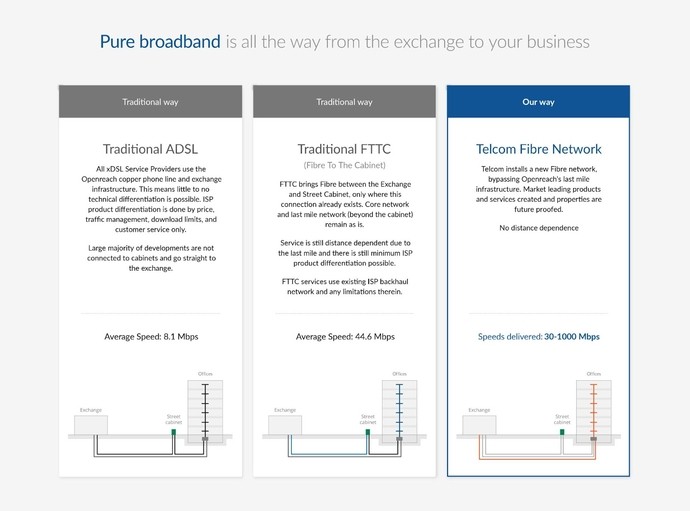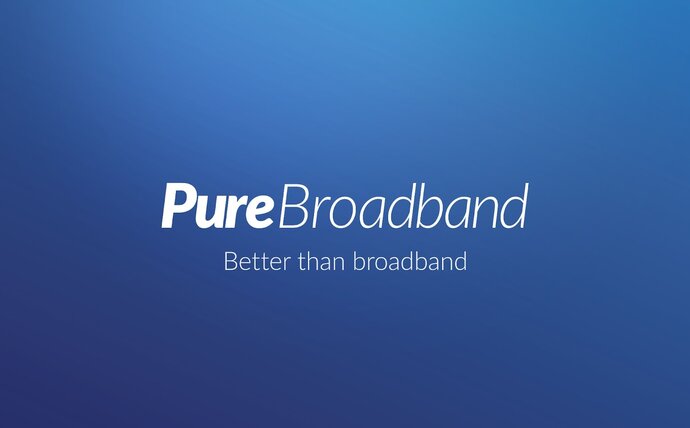In telecommunications, a broadband signalling method is one that handles a wide band of frequencies. As such the term “Broadband” is considered to be relative and understood according to its context. The wider (or broader) the bandwidth of a channel, the greater the data-carrying capacity, given the same channel quality.
The term became popularised through the 1990s as a marketing term for Internet access that was faster than dial-up access (dial-up being typically limited to a maximum of 56 kbit/s).
What is Broadband?
Broadband is a way of connecting to the internet. It allows information to be carried at high speed to your personal computer, laptop, tablet, smartphone, smart TV or other web-enabled device.
Broadband has largely replaced the original ‘dial-up’ (narrowband) method of connecting to the internet, which was much slower.
Broadband is often (but not always) used as a means to describe a shared or contended internet service. What does contended mean? While contention ratio is often overlooked as an important factor when choosing broadband, it is crucially important that businesses take it into consideration.
The contention ratio is the number of users sharing the same bandwidth and line. If the contention ratio is 50:1, 49 users other than yourself could be sharing bandwidth with you at any time. If the ratio is 1:1, only your business is using the line and therefore doesn’t have to share bandwidth.
What are the different types of broadband?
The three most common types of fixed-line broadband in the UK are ADSL, cable and fibre.
ADSL
ADSL stands for Asymmetric Digital Subscriber Line and is the most commonly available type of broadband, delivered through the copper wires of your phone line.
Two different types of ADSL technology which are used in the UK - ADSL1 and ADSL2+.
ADSL1 is capable of a maximum speed of about 8Mbit/s, and ADSL2+ a maximum speed of about 24Mbit/s.
However, the broadband speeds via both types of ADSL will depend on how far you live from your telephone exchange - the further away you are, the lower the speeds and the actual speeds you receive will typically be much lower than the maximum speeds shown above.
Cable
Cable networks use fibre optic and coaxial cables to deliver superfast broadband services - as well as TV and phone services - direct to homes.
Unlike with ADSL, speeds are not lost with distance. Cable technology can deliver very fast broadband speeds and the fastest cable broadband packages offer speeds of ‘up to’ 152Mbit/s
Fibre
Fibre broadband is delivered via clusters of fibre optic cables (each one thinner than a human hair) and speeds are faster than ADSL.
There are two types of superfast fibre broadband - ‘fibre-to-the-cabinet’ (FTTC) and ‘fibre-to-the-premises’ (FTTP).
With fibre-to-the-cabinet, fibre optic cables run from the telephone exchange to street cabinets before using standard copper telephone wires to connect to homes.
Most ‘broadband fibre’ connections in the UK are fibre-to-the-cabinet services, and are typically sold as offering speeds of ‘up to’ 38Mbit/s or 76Mbit/s.
Fibre-to-the-premises broadband - which, as the name suggests, involves fibre optic cables running directly to your business - is faster than fibre-to-the-cabinet but currently only constitutes a minority of broadband connections.
Fibre-to-the-premises broadband services can offer speeds of up to 1Gbit/s (i.e. 1,000Mbit/s).

How PureBroadband redefines business broadband
As a business it can be difficult to separate ‘fibre broadband’ from ‘100% Full Fibre broadband’ when engaging the market to find a broadband solution to support your business needs. The wrong type of broadband can end up costing a business thousands of pounds in lost productivity and hamper the overall customer experience they aspire to achieve.
We’ve built a business broadband solution from the ground up, one that is worthy of the ‘Pure’ title, in that it is 100% Full Fibre from the datacenter to your business, bypassing the legacy Victorian copper infrastructure. We’ve also enhanced the business broadband experience and made it easier to setup and connect with a broadband service in the way that fits your businesses needs:
- No IT support needed. When it comes to ordering business broadband most providers will give you a wireless router and then leave you to fend for yourself in terms of how you make that broadband connection work for your business, which for a lot of businesses just isn’t enough. We’ve baked almost a decade of experience servicing small businesses customer’s into how we deliver our business broadband and as such have designed unique PureBroadband bundles that ensure the connection is delivered how your business needs it without having to engage a third party IT support company in order to help you set your broadband experience up.
- Future-proof & scalable. 100% Full Fibre broadband will service your needs for decades to come, if not forever. As fibre optic technology evolves, you’ll already have everything that you need in your PureBroadband connection to enjoy all the benefits fibre has to offer - upgrade or downgrade your speed without ever needing an engineer to visit your business. Our Full Fibre broadband connection is built for scalability and can keep growing in line with your business, so if you ever need to move from PureBroadband to PureFibre, you’re connected and covered.
- Use more devices at once. Your team and your customers can use a lot more devices at once without experiencing slow down – so more people can get online at once. Even if you’re collecting payments, making calls, or have customers browsing your guest wifi, all at the same time - you won’t experience stuttering, buffering or dropouts.

Our PureBroadband customers have increased productivity and avoided costly downtime as a result of migrating to a 100% Full Fibre broadband connection.
These time and cost savings can add up: PDC Manchester, a North West provider of printing, estimates that they will save their operations team more than 300 hours per year, which they can refocus on growing their business.
“We save around 1.5 hours per week of waiting around, solely by having a broadband connection that’s capable of matching our business output. However, the biggest value will come as we scale and don’t need to worry about our connection running out of steam or replacing it when we hit a threshold.”
PureBroadband is now part of Telcom’s internet solutions

Today’s PureBroadband launch adds a key capability for businesses to take their first step towards a 100% Full Fibre solution and connect to the internet in the way their business needs without having to worry about costly additional IT support.
To begin with PureBroadband is only available in Manchester, however we will shortly be expanding PureBroadband to Liverpool, Leeds and Birmingham and build additional business bundle options to support other sectors, such as Retail .
You can get started with PureBroadband in Manchester today and visit our Business internet options for more information on our other business internet solutions.
